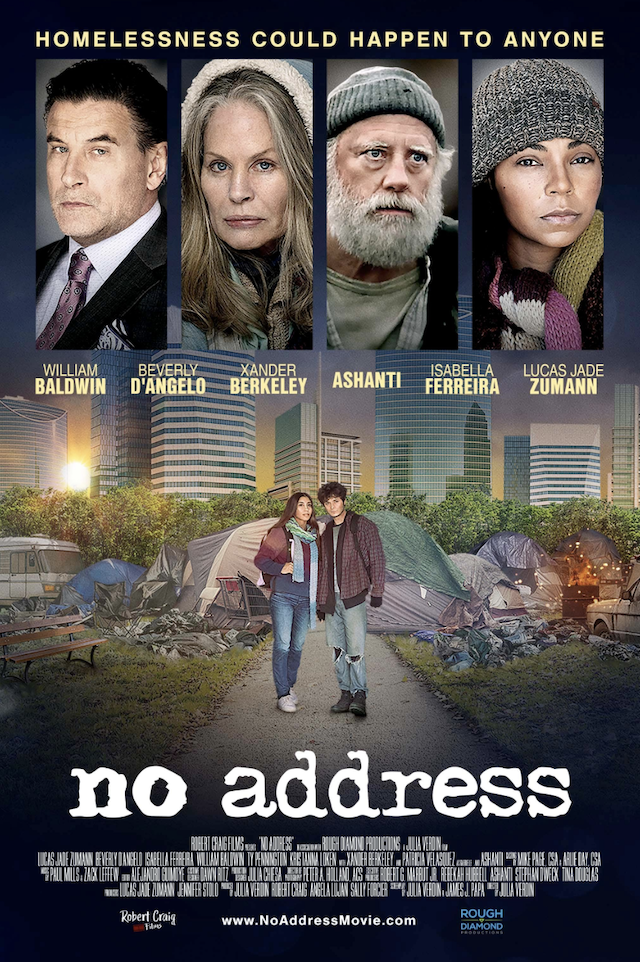
Society preaches the importance of caring for everyone, no matter what circumstances they find themselves in, during the current holiday season. But once the new year begins, many people’s consideration for those who are less fortunate seems to become quickly forgotten. The new emotionally gripping drama, No Address, showcases how people who experience homelessness are dehumanized from the world around them throughout most of the year.
The movie’s writer-director-producer, Julia Verdin, who co-scribed the screenplay with James J. Papa, were inspired to make the feature by true events. The duo’s script succeeded in their goal of sharing the realities of those struggling with homelessness with the world.
In No Address, Lauren’s (Isabella Ferreira) favorite pastime was capturing special moments with her loving mother on her Polaroid camera. Tragically, at the age of nine, Lauren then witnesses the unexpected death of her mother.
As many lonely years go by, Lauren finally graduates from high school. After she proudly walks home with her high school diploma, she finds her belongings from her foster care home stuffed into trash bags and left outside the front door. Unsure of where to go, Lauren falls asleep on the doorstep, awakening to the harsh reality that she has no address.
As Lauren navigates the merciless streets, she meets Jimmy (Lucas Jade Zumann), a kind-hearted runaway. He teaches her survival skills he has grown accustomed to after escaping his father’s violent abuse. He introduces her to an unconventional family forged on the streets: Harris (Xander Berkeley), a gifted painter and battle-scarred veteran; Dora (Beverly D’Angelo), a once-glimmering actress now battling her mind; and Violet (Ashanti), also a veteran fighting her own wars with addiction. Harris champions his street family to get their lives back as they are constantly warding off a harassing gang, unforgiving community and local authorities.
Meanwhile, Robert (William Baldwin), a once-successful businessman in the throes of financial ruin due to his gambling addiction, is desperate to take back the land the street family lives on for a prosperous development project. Soon his family will have to face the reality of his own financial nightmare and may even need help from those he once despised.
Ferreira and her main co-stars who portray the protagonist’s newfound family on the streets, including D’Angelo, Zumann, Berkeley and Ashanti, infused their characters with a sense of humanity and resilience. Lauren, Jimmy, Harris, Dora and Violet encompass the pain – and hope – the characters contend with as they navigate the challenges of living without a physical address.
In the movie’s screenplay, Verdin and Papa created a testament to the enduring human spirit and the transformative power of community by basing the main characters’ arcs on true events they’ve witnessed in their lives. Verdin has stated that she was driven to make the drama because after she was walking to her car in the pouring rain one day, she saw a homeless man huddled under an office building’s awning with his dog.
That image stuck with the filmmaker and still haunts her. As a result, Verdin worked with the movie’s cinematographer, Peter Holland, to create captivating and sentimental imagery in order to humanize Lauren’s new street family. Intimate close-ups of Lauren and her new family that emphasize their determination to help each other survive are the drama’s visual pinnacle. Combined with wider shots that capture the danger they face as they struggle on the streets, No Address‘ cinematography offers a powerful glimpse into the main characters’ daily lives.
While penning the film’s script, Verdin and Papa emphasized how some young adults become homeless because they either don’t have any family to take care of them or it’s safer than their homes. While preparing to make the movie, Verdin spoke to a girl who, like Lauren in the story, arrived home on her 18th birthday, and her foster parents left her belongings on the doorstep because wouldn’t be getting checks any more. A boy told the filmmaker how he ran away from an abusive and bullying father and ended up living on the streets. His experience inspired Jimmy’s character arc in the movie.
Those stories that inspired the character development in Verdin and Papa’s script also influenced the wardrobe the young protagonist and her new family wore throughout the drama. Lauren, Jimmy, Harris, Dora and Violet are often shown wearing worn, threadbare coats, hats and scarves to help them battle the colder weather in their community. In contrast, the supporting characters who are more fortunate to have a stable home are often shown wearing more polished and refined shirts and pants. Overall, the costumes reflect the film’s overall message that people who have been abandoned by society can be often be left unable to keep up with the cost of living, despite their best intentions to improve their life circumstances.
Overall, No Address succeeds in Verdin’s mission to vividly portrays that homelessness could happen to anyone, despite their seemingly initial good fortune. Through her touching, emotional screenplay, which Ferreira and her co-stars bring to the screen in endearing performances captured by Holland‘s visionary cinematography, the movie is a touching tribute to those who have been forgotten by society.
The filmmaker’s story serves as a homage to those who are not on the streets by choice. No Address is a profound feature that portrays the bleak realities of homelessness and the sadness that comes from an unfulfilled life, while at the same time showing how love and the will to survive brings hope to society overall.
Overall: B
No Address had its World Premiere earlier this month at the Fort Lauderdale International Film Festival. The drama will be released in theaters on February 28, 2025.
If you like the review, share your thoughts below!

